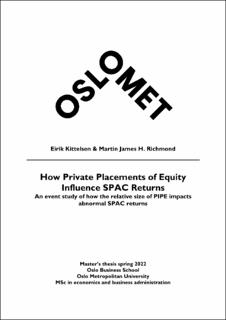How Private Placements of Equity Influence SPAC Returns. An event study of how the relative size of PIPE impacts abnormal SPAC returns
Master thesis
Submitted version
Permanent lenke
https://hdl.handle.net/11250/3030544Utgivelsesdato
2022Metadata
Vis full innførselSamlinger
Sammendrag
This thesis conducts an event study of how the size of capital raised by special purpose
acquisition companies (SPAC) through private investment in public equity (PIPE) affects the
performance of SPACs. This is done by looking at the daily abnormal stock returns at the
event window affiliated with the PIPE-announcement, as well as the long-term returns
following the event window. To be able to measure and compare the size of a SPAC’s PIPEfunding,
the companies are grouped into quintiles based on the size of what will be referred to
as PIPE-ratio, which is a relative PIPE measurement. The quintile portfolios consist of 52
companies each, all merged through SPACs listed in the U.S. between 2008 and 2022.
From the output it can be observed that the market reacts positively to the announcement in
the event window for the portfolios in our sample and the portfolio with the largest PIPE-ratio
exhibits the largest abnormal returns. All the portfolios experience statistically significant
different returns between the estimation period and either the event window or the event day,
except for the portfolio with the smallest PIPE-ratio. When testing the differences in abnormal
returns between the portfolios in the event window, there is evidence of the largest PIPE-ratio
portfolio yielding on average greater returns compared to the other portfolios. This shows that
SPACs with very large relative PIPE-funding have on average higher returns compared to
SPACs with lower relative PIPE-funding.
In the long run, the smallest and largest PIPE-ratio portfolios exhibit evidence of lesser and
greater relative returns respectively. However, the evidence of difference is lost when
controlling for, amongst other variables, recent SPAC activity and redemption rates. The
output then shows statistically significant lesser returns in the portfolio with the second largest
PIPE-ratios, when compared to the other portfolios.
